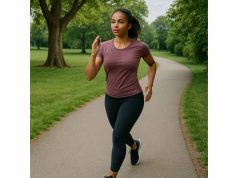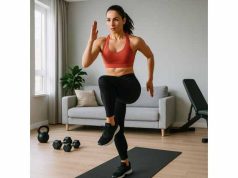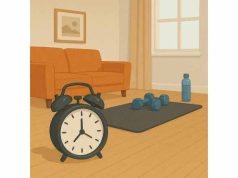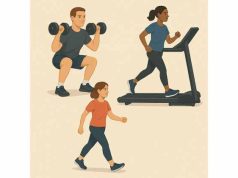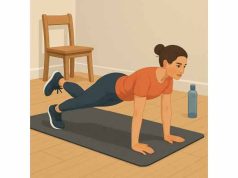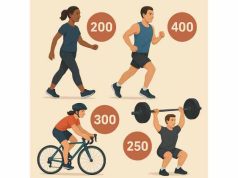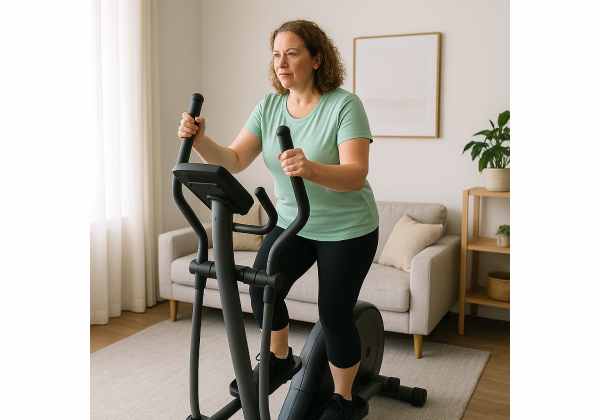
When your knees ache, cardio often feels out of reach. The good news: you do not need pounding jumps or long runs to raise your heart rate and support weight loss. Low-impact training—done with smart technique and the right pacing—can build fitness, protect joints, and help you stay consistent. This guide explains which options stress knees the least, how to set intensity, and how to program a week that balances calorie burn with recovery. We will also cover common mistakes that aggravate knee pain and the adjustments that usually fix them. For a broader look at how strength, cardio, and daily steps work together during a fat-loss phase, see our concise overview of exercise for weight loss planning.
Table of Contents
- What counts as low-impact cardio
- Best low-impact cardio for bad knees
- Intensity zones and calorie burn
- Weekly programming examples
- Form modifications and technique
- Pain guidelines and when to avoid
- Mistakes and troubleshooting
- Frequently Asked Questions
What counts as low-impact cardio
Low-impact means your joints experience minimal direct impact forces per step or repetition. It does not mean low intensity. You can breathe hard and burn many calories on joint-friendly machines or in the water, provided the movement keeps knee load smooth and controlled.
Impact vs. load
- Impact is the shock at ground contact (high when running or jumping).
- Load is the torque and shear across the knee from leverage, depth, and resistance. A steep cycling gear may be “low impact” yet still high load for the knee. Joint-friendly cardio lowers both, or lowers impact and manages load with good mechanics.
Qualities of true low-impact sessions
- Continuous support: Your body weight is supported by pedals, water, or a moving platform (bike, elliptical, rower, pool).
- Predictable path: The foot or hand follows a guided track, reducing sudden twisting.
- Cadence emphasis: You modulate effort with cadence and light-to-moderate resistance rather than heavy gears or extreme inclines.
- Stable alignment: Hips, knees, and feet track in line; the trunk remains controlled.
How this supports weight loss
Low-impact cardio enables frequency. When sessions do not flare symptoms, you can accumulate more weekly minutes. That consistency matters more than any single workout. Pairing low-impact cardio with daily steps and simple strength work preserves muscle while you lose fat.
A practical checklist to qualify an activity as “knee-friendly”
- Pain during exercise ≤ 2 out of 10 that resolves within 24 hours.
- No joint swelling or “catching” afterward.
- You can maintain good technique for at least 15–20 minutes without form unraveling.
- Intensity rises mainly through cadence and breath, not by grinding against heavy resistance.
Examples that usually qualify
- Stationary cycling (upright or recumbent) with light to moderate gearing.
- Elliptical trainer with small to moderate incline.
- Rowing ergometer with a comfortable knee angle at the catch.
- Deep-water running or pool intervals.
- Brisk walking on level ground or gentle incline, using shorter strides.
- Upper-body ergometer for days when knees need a break.
Where to start in your week
Most people do well with 3–5 sessions of low-impact cardio plus daily steps, alongside two light strength sessions for hips and core. The exact number of rest days depends on your training age, stress, and sleep. For a quick refresher on this big-picture setup, visit our page on safe weight-loss fundamentals.
Best low-impact cardio for bad knees
Several modes deliver solid conditioning while keeping knee stress manageable. Choose one or two favorites for your primary sessions, then rotate others for variety and recovery.
1) Stationary bike (upright or recumbent)
- Why it works: Seated support reduces impact; cadence lets you scale intensity without heavy torque.
- Set-up tips: Seat height so the knee is slightly bent at the bottom (~25–35°). Knees track over the middle of the foot; avoid caving inward. Hips remain level with minimal rocking.
- How to progress: Build time first (20 → 30 → 40 minutes). Only then add brief cadence surges. Keep resistance light to moderate to avoid grinding.
2) Elliptical trainer
- Why it works: Foot stays in contact with the platform; stride path is guided, limiting joint shear.
- Set-up tips: Choose a stride length that feels natural. Start with low to moderate incline and resistance. Keep posture tall with light hand support.
- Use case: Great on days when walking feels tender. For interval ideas, see our concise elliptical intervals.
3) Rowing ergometer
- Why it works: Full-body drive with hips and back sharing the work.
- Knee-friendly cues: Shorten the catch (do not slam heels toward the seat). Focus on strong hip drive and a smooth return. Keep the stroke rate modest (22–26 spm) as you learn.
- When to avoid: Recent meniscus flare or sharp pain at deep knee bend.
4) Deep-water running or swimming
- Why it works: Buoyancy unloads joints while allowing high heart-rate work.
- How to progress: Alternate 1–2 minutes hard with 1–2 minutes easy for 20–30 minutes. Keep the torso tall and avoid extreme knee lift.
5) Walking (outdoors or treadmill)
- Why it works: Natural, accessible, and adjustable through pace and incline.
- Knee-friendly cues: Use a shorter stride and quicker cadence. Favor 0–3% incline to reduce braking forces; avoid long downhill bouts.
- When symptoms flare: Substitute cycling or elliptical for a few sessions, then reintroduce walking gradually.
6) Upper-body ergometer (UBE)
- Why it works: Provides a cardio option on bad-knee days so you do not lose momentum.
- How to progress: Interval format works best (for example, 45 seconds moderate, 15 seconds easy × 15–20).
7) Hybrid circuits
On days when one joint feels cranky, combine two modes—e.g., 8 minutes bike + 8 minutes elliptical + 8 minutes row—to keep effort up while spreading load.
Choosing the “best” for you
- Pick the mode that lets you train today and tomorrow without increased pain or swelling.
- Prefer sessions where you can breathe hard with technique intact for 20–30 minutes.
- Rotate options across the week to distribute stress and maintain motivation.
Intensity zones and calorie burn
Low-impact does not have to mean low effort. Use clear intensity anchors so you work hard enough to progress while keeping knees calm.
Three simple anchors
- Talk test / RPE
- Easy (RPE 3–4): Full sentences. Warm-ups, recovery rides, longer walks.
- Moderate (RPE 5–6): Short phrases. Most fat-loss cardio should live here.
- Hard (RPE 7–8): One- to two-word answers. Short intervals, used sparingly.
- Heart-rate ranges
- Zone 2 (roughly 60–70% HRmax): Steady efforts that build aerobic capacity without lingering fatigue.
- Tempo (70–80% HRmax): Sustained but controlled; best reserved for short blocks.
- High-intensity bursts (>80% HRmax): Time-efficient, but knees may prefer machines with guided motion. For a deeper primer on aerobic base work, skim our guide to Zone 2 basics.
- Power or cadence (machine-specific)
- Bike: Keep cadence 80–95 rpm on light to moderate resistance; avoid straining below ~70 rpm.
- Elliptical: Smooth strides with consistent rhythm; adjust resistance in small steps.
- Rower: Stroke rate 22–26 spm for steady work, 26–30 spm for short intervals.
How to combine zones for fat loss with knee sensitivity
- Foundation: 2–4 sessions of Zone-2 style work (20–45 minutes each).
- Sprinkles of intensity: 1–2 short interval sessions weekly on a knee-friendly mode (bike, elliptical, pool, or rower with a shortened catch).
- Micro-progressions: Add 5 minutes to one steady session per week, or add two interval repeats, not both.
Calorie burn: realistic expectations
Calorie expenditure varies with body mass, fitness, machine calibration, and efficiency. As a general pattern at moderate intensity:
- Cycling and elliptical tend to burn similar calories per minute.
- Rowing slightly higher if technique is efficient.
- Brisk walking somewhat lower per minute but easier to sustain and repeat.
Treat machine readouts as ballpark. Consistent minutes and heart-rate anchors tell you more than any single number.
Monitoring fatigue without overreacting
- Green light: Normal muscle stiffness that fades within 24 hours; no joint swelling.
- Yellow light: Soreness at the front of the knee that persists beyond 24–36 hours—reduce resistance and stride length, and shift one session to the pool or UBE.
- Red light: Sharp pain, catching/locking, or new swelling—stop and consult a clinician.
Why steady work still matters
Intervals are efficient, but the weekly minutes you can complete comfortably drive most of your progress. A base of Zone-2 time improves recovery, lowers perceived exertion at a given pace, and usually permits more total training without joint irritation.
Weekly programming examples
These templates balance calorie burn, knee comfort, and recovery. Adjust durations to match your current capacity and time.
A) Beginner, sore knees (3 cardio days + steps)
- Mon: Bike 20–25 min easy-moderate (cadence 85–90 rpm).
- Tue: 7,000–9,000 steps in short walks (10–15 min blocks).
- Wed: Elliptical 20–25 min steady.
- Thu: Restorative mobility 10–15 min; light household movement.
- Fri: Deep-water running 20–30 min: 1 min moderate / 1 min easy.
- Sat: Steps day, aim for 8,000–10,000 with level routes.
- Sun: Full rest.
Progression: Add 5 minutes to one machine session each week, or add two rounds to the water intervals.
B) Time-crunched (2 cardio days + 1 mixed day)
- Tue: Bike intervals 8×(1 min hard, 2 min easy) after 10-min warm-up; cool down 5 min.
- Thu: 30–35 min brisk treadmill walk at 0–3% incline, shorter steps.
- Sat: Hybrid 30 min: 10 min row (short catch) + 10 min bike + 10 min elliptical, all moderate.
Progression: Add one interval rep on Tuesdays, or extend Saturday’s hybrid by 5 minutes.
C) Pool-focused (knee flare week)
- Mon: Swim or deep-water run 25–35 min steady.
- Wed: Pool intervals 12×(45 sec hard, 45 sec easy).
- Fri: Elliptical 20–25 min easy-moderate for variety.
- Daily: Gentle mobility and 6,000–8,000 steps split into short walks.
Strength and mobility (2 short sessions weekly)
- Session 1 (15–20 min): Hip hinging (bodyweight RDL), glute bridge, side-lying hip abduction, calf raises, plank.
- Session 2 (15–20 min): Step-up to a low platform (pain-free height), mini-band lateral walk, terminal knee extension with band, bird-dog, thoracic rotations.
Keep efforts submaximal and technique-driven.
Rest planning
Maintain one to two rest days per week. If fatigue accumulates, drop intervals for seven days while keeping easy aerobic work. For more on balancing stress and recovery across the week, review our summary on rest day planning.
Form modifications and technique
Small adjustments often make the difference between a tolerable session and a painful one.
Cycling
- Seat height: Aim for a soft knee angle at the bottom of the stroke (~25–35°). Too low raises patellar stress.
- Saddle fore-aft: Knee above mid-foot at 3 o’clock; if the knee sits far forward, slide the saddle back a few millimeters.
- Cadence: Favor 80–95 rpm. Increase effort with cadence before resistance.
- Foot alignment: Point toes forward; avoid knees collapsing inward.
Elliptical
- Stride and incline: Start with a moderate stride and low incline. Excessive incline increases knee and hip flexion.
- Posture: Tall torso, light hands, relaxed shoulders. Let legs drive the motion; avoid pulling with arms early on.
- Resistance: Use small steps in resistance. If the stride feels “sticky,” reduce resistance and increase cadence.
Rowing
- Shorten the catch: Stop before the heels crowd the seat. This reduces knee compression.
- Drive order: Legs → hips → arms; reverse on the recovery.
- Damper setting: Moderate setting (often 3–5) keeps strokes smooth and knee-friendly.
Walking (outdoors or treadmill)
- Stride length: Shorter step, slightly higher cadence. Overstriding increases braking and knee stress.
- Incline: 0–3% to reduce impact; avoid extended downhill.
- Poles: Trekking poles unload joints on uneven terrain and improve rhythm.
Aquatic options
- Deep-water belt: Keeps you vertical without sculling stress at the knees.
- Kick choice: Emphasize flutter kicks within a pain-free range; avoid whip kicks if they aggravate the joint.
Footwear and surfaces
- Cushioned yet stable shoes for treadmill or outdoor concrete.
- Softer paths (track, packed dirt) are often kinder than cambered roads.
Warm-up and cooldown
- 5 minutes very easy pace, then gradual build.
- Finish with gentle range-of-motion and diaphragmatic breathing. For a structured routine, see our guide to warm-up and mobility.
Pain guidelines and when to avoid
You should expect some normal training fatigue. Pain needs clearer rules.
Green-yellow-red framework
- Green: Discomfort ≤ 2/10 during activity, gone by the next morning. Continue as planned.
- Yellow: Pain 3–5/10 during or after, or stiffness lasting > 24–36 hours. Reduce resistance, shorten sessions by 20–30%, and swap one workout for pool or UBE.
- Red: Sharp pain, new swelling, joint catching, or giving way. Stop the session and seek medical assessment.
Programming adjustments that help
- Alternate knee-friendlier modes (bike, pool) with slightly more demanding ones (elliptical, brisk walking).
- Break long sessions into two shorter bouts (e.g., 2×15 minutes) on flare weeks.
- Favor cadence increases over heavy resistance; avoid big gear starts.
When to consult a clinician
- Pain interrupts sleep or daily tasks.
- Swelling persists beyond 48 hours after low-impact sessions.
- Recent surgery, acute injury, or a history of knee instability.
- You are unsure whether symptoms reflect joint irritation or muscular soreness.
Non-exercise movement matters
On tender days, maintain caloric expenditure with NEAT: more standing, light chores, and short walks. For step-based strategies that scale without irritating the joint, see our overview of daily step targets.
Mistakes and troubleshooting
Protect your knees and your progress by avoiding these common errors.
Mistake 1: Overstriding on the treadmill
- Fix: Shorten your step and raise cadence. Keep incline modest (0–3%). If pain persists, switch one session to the bike.
Mistake 2: Grinding heavy gears on the bike
- Fix: Lower resistance, bring cadence to 80–95 rpm, and progress time before intensity.
Mistake 3: Chasing intensity every day
- Fix: Limit hard intervals to 1–2 sessions per week. Keep the rest steady and conversational.
Mistake 4: Ignoring set-up
- Fix: Spend 3–4 minutes dialing in seat height, stride, and posture each time. Small changes add up over hundreds of strokes.
Mistake 5: Skipping warm-ups and cooldowns
- Fix: Begin every session with 5 minutes easy and finish with gentle mobility and slow breathing. It lowers stiffness and improves adherence.
Mistake 6: Staying on one mode despite irritation
- Fix: Rotate to pool or UBE when symptoms rise. Maintain frequency and minutes with the least provocative option.
Mistake 7: Letting long sedentary blocks undo progress
- Fix: Insert two to three 5–10 minute walks or mobility breaks on non-training days to keep joints comfortable and energy use steady.
Frequently Asked Questions
Is low-impact cardio enough for weight loss if I have knee pain?
Yes. Combine 3–5 weekly sessions of low-impact cardio with daily steps and two brief strength sessions for hips and core. Weight loss depends on total activity and nutrition, not high impact. Consistency and pain-free practice make adherence—and results—more likely.
Which machine is easiest on sore knees: bike, elliptical, or rower?
Most find the bike most forgiving when resistance stays light to moderate and cadence is 80–95 rpm. The elliptical is also joint-friendly with a moderate incline. The rower works well if you shorten the catch and keep strokes smooth.
How many minutes should I aim for each week?
A practical target is 120–180 minutes of low-impact cardio, mostly at an easy to moderate pace, plus daily steps. Start lower if pain is active and add 5–10 minutes to one session per week. Short, frequent bouts are better than long, painful ones.
Can I do HIIT with bad knees?
Often yes—on knee-friendly modes. Choose bike, pool, or elliptical and keep intervals short (30–60 seconds hard, 60–120 seconds easy). Limit to one or two sessions per week and stop if pain rises above mild discomfort or lingers beyond a day.
Does walking downhill harm my knees?
Extended downhill walking increases braking forces and may aggravate the front of the knee. Prefer level ground, gentle inclines, or treadmill walking at 0–3% incline. Use shorter strides and higher cadence; switch to cycling or pool work on flare days.
Should I wear a knee brace for cardio?
A simple compression sleeve can improve comfort and swelling control for some people. Bracing should not replace good set-up, cadence, or strength work. If you need a rigid brace to exercise, consult a clinician to review fit and training plan.
How do I know if I am overdoing it?
Use the 24-hour rule: discomfort should be mild and gone by the next day. Watch for swelling, sharp pain, or joint “catching.” If symptoms persist beyond 24–36 hours, cut volume by 20–30%, reduce resistance, and rotate to a gentler mode for a week.
References
- EULAR recommendations for the non-pharmacological core management of hip and knee osteoarthritis: 2023 update 2024 (Guideline)
- 2019 American College of Rheumatology/Arthritis Foundation Guideline for the Management of Osteoarthritis of the Hand, Hip, and Knee 2020 (Guideline)
- Exercise Therapy for Knee Osteoarthritis: A Systematic Review and Network Meta-analysis 2023 (Systematic Review)
- Overall treatment effects of aquatic physical therapy in knee osteoarthritis: a systematic review and meta-analysis 2022 (Systematic Review)
- High-Intensity Interval Training for Knee Osteoarthritis: A Pilot Study 2021 (RCT)
Medical Disclaimer
The information in this article is educational and not a substitute for individualized medical advice. Consult your healthcare professional before starting or changing exercise, especially if you have knee osteoarthritis, a recent injury or surgery, systemic disease, or take medications that affect heart rate or blood pressure. Stop activity and seek care if you experience sharp pain, joint locking, giving way, or persistent swelling.
Share and Stay Connected
If this guide helped you find knee-friendly ways to keep moving, please share it with someone who would benefit and consider following us on your preferred social platforms. Your support helps us continue creating clear, evidence-informed resources.

